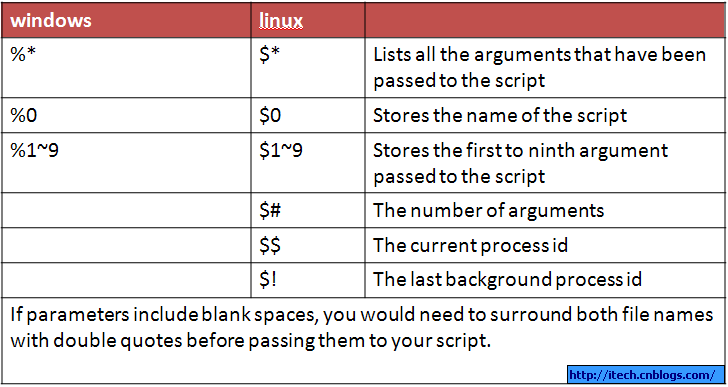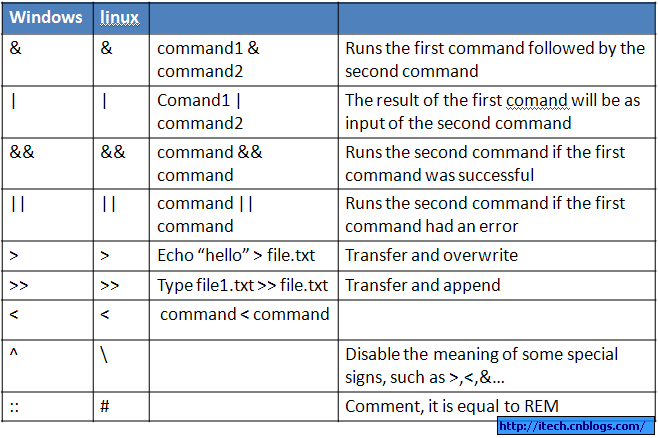一 简单实例
1)batch file
 @echo off
@echo off
 rem output helloworld
rem output helloworld :: output helloworld
:: output helloworld
 Echo Hello World!
Echo Hello World!小结:
- batch file一般以bat或cmd为后缀。
- 第一行为@echo off表示关闭运行时batch file本身输入,只输出运行的结果。
- rem和::表示注释。
2)shell file
 #!/bin/sh
#!/bin/sh
 # output helloworld
# output helloworld echo helloworld!
echo helloworld!小结:
-shell file一般以sh,ksh,bash等结尾。
-第一行为#!/bin/sh用来用那种shell解释程序来解释本shell脚本,因为shell有多种,常见的有sh,ksh,tsh,bash等。
-#用来在shell中表示注释。
-shell file执行前需要修改权限为可执行,例如:chmod a+x shellfile.sh。
二 变量
1)batch file
 Set Name = Value
Set Name = Value Set path = Name;%PATH%
Set path = Name;%PATH% Echo %path%
Echo %path%
小结:
-用set来定义变量,=两边不可以使用空格。
-变量间用;隔开。
-使用%%来使用变量的值。
2) shell file
 Name=Value
Name=Value PATH=Name:$PATH
PATH=Name:$PATH Echo $PATH
Echo $PATH
小结:
-变量直接定义,且=两边不能有空格。
-变量间用:隔开。
-使用$来使用变量的值。
三 特殊变量
小结:
-可以使用shift来使用超过10个变量。
-windows的batchfiles中%~dp0%表示当前文件的目录。
四 变量的特殊用法
变量的替换:
1)batch file
 %VariableName:ReplacementString=OriginalString%
%VariableName:ReplacementString=OriginalString% set a=belcome to CMD borld!
set a=belcome to CMD borld! set temp=%a:b=w%
set temp=%a:b=w% echo %temp%
echo %temp% pause
pause 将显示 welcome to CMD world! 即用w替换了变量a中的b。
将显示 welcome to CMD world! 即用w替换了变量a中的b。2)shell file
 ${VAR/PATTERN/STRING} or ${VAR//PATTERN/STRING}
${VAR/PATTERN/STRING} or ${VAR//PATTERN/STRING}  语法。
语法。第一种形式仅仅替换第一个匹配的项目,第二个用 STRING 替换所有匹配 PATTERN 的项目。

变量求子串:
1)batch file
 %VariableName:~StartPosition,Length%
%VariableName:~StartPosition,Length% set a=superhero
set a=superhero  set temp=%a:~0,-3%
set temp=%a:~0,-3%  echo %temp%
echo %temp%  pause
pause  将显示superh 即显示了变量a的第0位和第-3位中间包含的所有字符。
将显示superh 即显示了变量a的第0位和第-3位中间包含的所有字符。
2) shell file
 ${varname:offset:length} Purpose: Returning parts of a string (substrings or slices).
${varname:offset:length} Purpose: Returning parts of a string (substrings or slices). STRING="thisisaverylongname"
STRING="thisisaverylongname"  echo ${STRING:6:5}
echo ${STRING:6:5} 
shell file中的其他的特殊用法:
 a. 变量=${参数-word}:如果设置了参数,则用参数的值置换变量的值,否则用word置换。即这种变量的值等于某一个参数的值,如果该参数没有设置,则变量就等于word的值。
a. 变量=${参数-word}:如果设置了参数,则用参数的值置换变量的值,否则用word置换。即这种变量的值等于某一个参数的值,如果该参数没有设置,则变量就等于word的值。 b. 变量=${参数=word}:如果设置了参数,则用参数的值置换变量的值,否则把变量设置成word,然后再用word替换参数的值。注意,位置参数不能用于这种方式,因为在Shell程序中不能为位置参数赋值。
b. 变量=${参数=word}:如果设置了参数,则用参数的值置换变量的值,否则把变量设置成word,然后再用word替换参数的值。注意,位置参数不能用于这种方式,因为在Shell程序中不能为位置参数赋值。 c. 变量=${参数?word}:如果设置了参数,则用参数的值置换变量的值,否则就显示word并从Shell中退出,如果省略了word,则显示标准信息。这种变量要求一定等于某一个参数的值。如果该参数没有设置,就显示一个信息,然后退出,因此这种方式常用于出错指示。
c. 变量=${参数?word}:如果设置了参数,则用参数的值置换变量的值,否则就显示word并从Shell中退出,如果省略了word,则显示标准信息。这种变量要求一定等于某一个参数的值。如果该参数没有设置,就显示一个信息,然后退出,因此这种方式常用于出错指示。 d. 变量=${参数+word}:如果设置了参数,则用word置换变量,否则不进行置换。
d. 变量=${参数+word}:如果设置了参数,则用word置换变量,否则不进行置换。
五 Call/start/source/sh
1)batch file中call/start
call, 父bat中的vars可以在子bat中访问,且子bat的修改可以返回到父bat中,或者如果子bat中新定义的vars也可以带回到父中。(因为最后子bat和父bat在执行时被合并为同一个bat)。
Start,父bat中的vars可以在子bat中访问,但是子bat修改不会被反映到父bat中,且子中定义的变量不会被带到父中。(子bat和父bat是独立的进程)。
2) shell file中source/sh/.
Source同.命令,与batch file中的call相同,父shell中的vars可以在子shell中访问,且子shell的修改可以返回到父shell中,或者如果子shell中新定义的vars也可以带回到父中。(因为最后子shell和父shell在执行时被合并为同一个shell)。
Sh,同batch file的start,但是有区别,父shell中的vars不能被在子中访问,且子中的修改不会被反映到父shell中,子中定义的变量不能被带到父中。如果将父中的vars使用export导入子中,则在子中可见,但是修改仍不能被带回父中。(子shell和父shell是独立的进程)。
六 特殊符号
七 错误代码
1) batch file
-errorlevel用来上次命令的返回值,如果为0表示成功。
2) shell file
-$?用来表示上次命令的返回值,如果为0表示成功。
3)2> file 表示将错误重定向到file,2>&1 表示将错误输出重定向到与标准输出相同。0表示标准输入,1表示标准输入,2表示错误输出。
八 表达式计算
1)batch file
 SET /A variable = Expression
SET /A variable = Expression set /a var=5+2
set /a var=5+2  set /a var=55*34
set /a var=55*34  set /a var=55/34
set /a var=55/34 set /a var=55%%34
set /a var=55%%34 set /a var= (8+(9/3+7))*3
set /a var= (8+(9/3+7))*3 但set /a vat=55.1*34是错误的,因为批处理不支持浮点运算。
但set /a vat=55.1*34是错误的,因为批处理不支持浮点运算。
 SET /A x = 1
SET /A x = 1  SET /A y = 2
SET /A y = 2  SET /A z = x + y + 3
SET /A z = x + y + 3  ECHO z
ECHO z2)shell file
 a=2
a=2 c=5
c=5 let b=$a*$c
let b=$a*$c echo $b
echo $b
 $((i++))
$((i++))
 $((3 > 2))
$((3 > 2))  $(( (3 > 2) || (4 <= 1) ))
$(( (3 > 2) || (4 <= 1) )) 
 declare -i val3=12 val4=5
declare -i val3=12 val4=5 declare -i result2
declare -i result2 result2=val3*val4
result2=val3*val4 echo $result2
echo $result2小结:
Shell file中:
1) 常用运算符号:
++ Increment by one (prefix and postfix)
— Decrement by one (prefix and postfix)
+ Plus
- Minus
* Multiplication
/ Division (with truncation)
% Remainder
** Exponentiation[10]
<< Bit-shift left
>> Bit-shift right
& Bitwise and
| Bitwise or
~ Bitwise not
! Logical not
^ Bitwise exclusive or
, Sequential evaluation
2) 字符串比较:
< Less than
> Greater than
<= Less than or equal to
>= Greater than or equal to
== Equal to
!= Not equal to
&& Logical and
|| Logical or
3) 整数比较:
-lt Less than
-gt Greater than
-le Less than or equal to
-ge Greater than or equal to
-eq Equal to
-ne Not equal to
九 完!